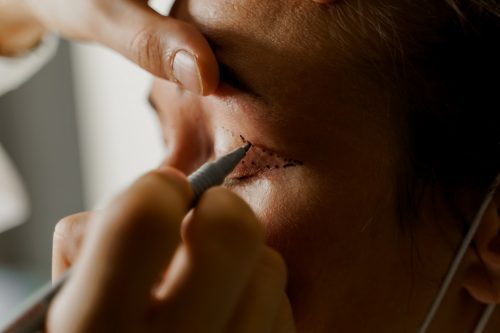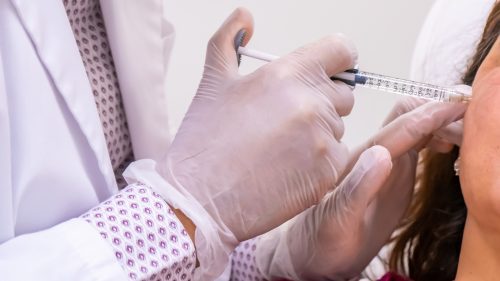Cosmetic eyelid surgery, or blepharoplasty, is the second-most common cosmetic surgery procedure in the United States. In 2020, more than 325,000 patients underwent the surgery, according to the American Society of Plastic Surgeons. Michael K. Yoon, MD, a member of the Mass Eye and Ear Ophthalmic Plastic Surgery Service, explained cosmetic eyelid surgery, and who might benefit most.
What might prompt someone to look into cosmetic eyelid surgery?
Patients may seek out cosmetic eyelid surgery based on the appearance of their eyelids, which may look puffy or droopy, or present as bags or dark circles under their eyes. I often hear from patients that they get unwelcomed comments from others who say they look tired.
A combination of factors might lead to this appearance, including aging, but genetics is likely the number one cause. We all look like our family members, and if your parents, grandma or uncle has droopy or puffy eyelids, then you might too.
What happens during a surgical consultation?
We first make sure that person is a good candidate for surgery. A complete exam can rule out other conditions that might be causing these appearances. For example, thyroid eye disease can result in puffiness, or certain neurologic conditions might cause eyelids to appear droopy. In rare cases, abnormal swellings or tumors might give the appearance of droopy eyelids.
If the patient is a candidate for cosmetic eyelid surgery, we discuss the different surgical and nonsurgical options and what they might expect. It is crucial that a patient has an understanding of both the procedures we offer and their expected outcomes. Communicating expectations is perhaps the most critical part of the consultation.
What are the expected outcomes of cosmetic eyelid surgery?
 My job as a surgeon is to give patients as clear a picture of what result they can expect. Some patients might bring in a past photo or a picture from a magazine or online to show what they want. Sometimes the answer is “yes, we can recapture that appearance,” while other times the answer is, “not quite.” Additionally, most patients prefer a subtle improvement so as to not appear as though they underwent cosmetic surgery.
My job as a surgeon is to give patients as clear a picture of what result they can expect. Some patients might bring in a past photo or a picture from a magazine or online to show what they want. Sometimes the answer is “yes, we can recapture that appearance,” while other times the answer is, “not quite.” Additionally, most patients prefer a subtle improvement so as to not appear as though they underwent cosmetic surgery.
Outcomes often rely on an individual patient’s anatomy. For example, how much skin a patient has and the current shape of his or her eyes and eyelids will be a major factor in outcomes.
I usually tell patients they can expect to have results from the surgery for 10 to 15 years. The changes we’re addressing are often age-related, and anybody will change over that time period. Even if the surgery dials back that clock a little bit, the clock keeps going.
What happens during cosmetic eyelid surgery?
Eyelid surgery is called a lid lift or blepharoplasty. This can be done on the upper or lower eyelids, or a combination of both.
The upper lids and lower lids are very similar in terms of surgery, but have some important distinctions. In upper eyelid surgery, an incision is made outside the eyelid to remove some skin to achieve the desired aesthetic improvement. Additionally we can remove some fat to eliminate puffiness.
Conversely, in lower eyelid surgery, an incision is made internally on the inside of the eyelid, and removal of fat is the primary objective. Occasionally excess skin is also removed.
One of the major decisions for a patient and their doctor is the type of anesthesia used. The majority of patients will have the surgery awake with mild sedation, also known as twilight anesthesia. An anesthetic agent gets injected into the eyelids to numb the area, while the sedative will make the patient feel relaxed and sleepy, and mitigate the pain. This procedure is typically done in the operating room.
The other option is when patients are completely awake, in which case the procedure is done in the office. Here, there is no sedation but the patient gets the same numbing agent in their eyelids and face. If a patient does not have anxiety about the procedure, this can be a nice option.
Regardless of where the surgery is performed, the procedures are done exactly the same way. The duration of surgery itself typically takes 30 to 90 minutes depending on if it’s on the upper or lower eyelids, or both. If the procedure is done in the operating room with anesthesia, the preparation and recovery will add two to three hours.
It is recommended someone drive you home after surgery because of eyelid swelling.
What is the recovery like from cosmetic eyelid surgery?
The hardest part of recovery for most patients is swelling and bruising. This tends to look like having a “black eye”. There tends to be more swelling and bruising for lower than upper eyelids, but most patients will experience this effect for two to three weeks.
Generally, there is a mild degree of postsurgical pain that can be treated with Tylenol and ice packs.
Some surgeons use different types of stitches. I use dissolving stiches which take two weeks to go away, but if a surgeon uses regular stitches they will need to be removed.
By week one or two, people will be able to see for themselves the effects of the surgery. They can see some changes right away; but once the swelling subsides, they will get a better idea of what they will look like after the healing is done. In some cases, it can take a few months for that process to play out.
Are these surgeries covered by insurance?
Eyelid surgery may be covered by insurance in some cases, such as if droopy eyelids are impairing vision. For many patients, however, they will pay out of pocket. That determination is made by the insurance company, not by the doctor.
Different types of surgeons perform these surgeries. How can I best choose?
Here at Mass Eye and Ear, cosmetic eyelid surgeries can be performed by oculoplastic surgeons in our ophthalmology department and facial plastic surgeons in our ENT department. Elsewhere different types of cosmetic surgeons offer the procedures.
What I tell everyone is it really doesn’t matter the doctor’s background, or what kind of residency they did. The most important thing is how frequently the doctor does that surgery and how successfully they do it.
The good news is that with qualified and experienced surgeons, the risks of a serious issue or cosmetically disappointing result is very low. It’s a highly successful, well-accepted surgery, and one of the most commonly performed cosmetic procedures in the United States.
 Are there nonsurgical options for patients?
Are there nonsurgical options for patients?
The main categories of nonsurgical options are neurotoxins (like Botox, Dysport, and Xeomin), fillers, and skin resurfacing. The neurotoxins are useful for softening “dynamic wrinkles” – ones that are seen in between the eyebrows, on the forehead, and crow’s feet areas when making certain facial expressions. Fillers as an alternative are generally useful in lower eyelids in patients with mild puffiness or bags. However in most people who have more substantial eyelid puffiness, it’s probably not an effective alternative; though in some cases fillers could be a supplement to surgery.
Skin resurfacing is useful to treat fine lines and wrinkles around the eyelids and face by tightening the skin and smoothing out its appearance. This is primarily done as a laser treatment or a chemical peel.
Patients can be offered a mix of these procedures or recommended one or the other. I want to make sure I’m choosing the right procedure and making the best recommendation for them.
If you’re interested in a consultation with a member of the Ophthalmic Plastic Surgery Service, contact 617-573-3202.
About our expert
 Michael K. Yoon, MD, is a member of the Mass. Eye and Ear Ophthalmic Plastic Surgery Service and Center for Thyroid Eye Disease and Orbital Surgery. He specializes in reconstructive and cosmetic eyelid surgery, orbital tumors and inflammations, traumatic lacerations and fractures.
Michael K. Yoon, MD, is a member of the Mass. Eye and Ear Ophthalmic Plastic Surgery Service and Center for Thyroid Eye Disease and Orbital Surgery. He specializes in reconstructive and cosmetic eyelid surgery, orbital tumors and inflammations, traumatic lacerations and fractures.
Thank you.
who much a person without inserance has to paid for a consultaion.
Eyelid surgery could be performed in a 81 years old and in good health woman?
Hi Alice, we can’t give specific medical advice on the blog, but feel free to contact 617-573-5550 for a consultation.
Dr. Yoon performed Eye lid surgery on both my eyelids last week. The surgery was done in his office and lasted approximately 30 minutes. I had my follow-up with Dr. Yoon today and everything was progressing as expected. I felt completely comfortable with Dr. Yoon as my surgeon!
I have already been diagnosed with the following however i can’t get in for a consultation with my provider until august 12th. Can I have the procedure done sooner at Mass Eye? Pt in for problem visit – redness, irritation and mild discharge OS>OD. OS has FB sensation and is much more uncomfortable than OD. Exam reveals blepharitis, injected lid margins, foamy tears and dry eyes OU, but OS also has intermittent entropion and inferior spk.FB tracking. No signs of infection today. Pt has not found relief with artificial tears several times a day for last several days. Rx given for tobradex qid OS x 4 days, bid x 2 days, qd x 1 day then stop (can use OU if OD is bothersome).
Hi Phillip, we unfortunately can’t comment on specific medical care over the blog, please call our Ophthalmic Plastic Surgery Service at 617-573-3202 for an appointment.
I was searching regard share big files free then an awesome blog landed on me your website, you maintained the blog very well and hooked your readers till the end of the article.